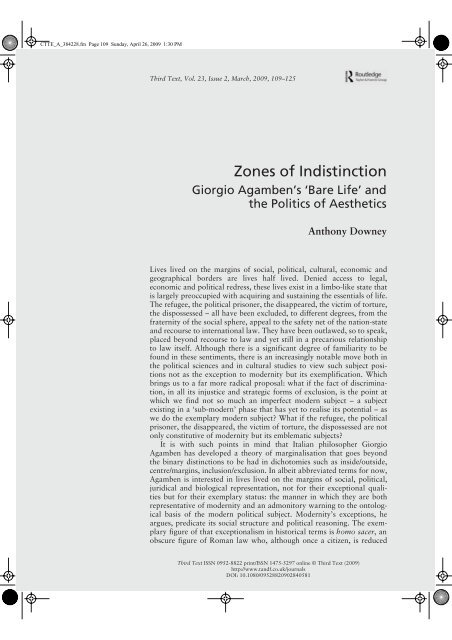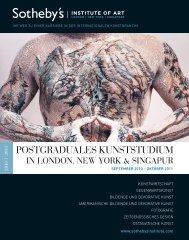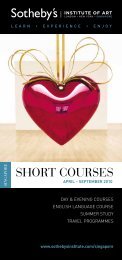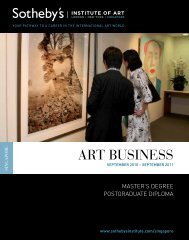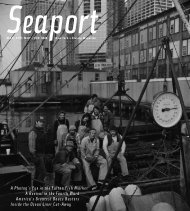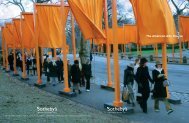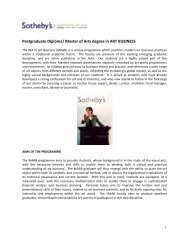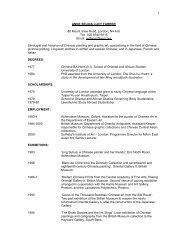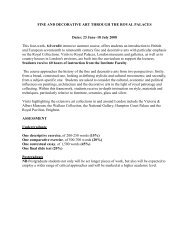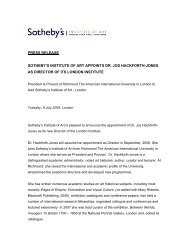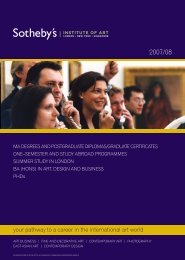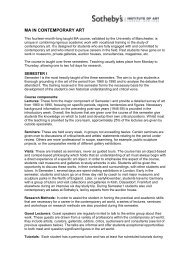Zones of Indistinction: Giorgio Agamben's Bare Life and
Zones of Indistinction: Giorgio Agamben's Bare Life and
Zones of Indistinction: Giorgio Agamben's Bare Life and
Create successful ePaper yourself
Turn your PDF publications into a flip-book with our unique Google optimized e-Paper software.
CTTE_A_384228.fm Page 109 Sunday, April 26, 2009 1:30 PM<br />
Third Text, Vol. 23, Issue 2, March, 2009, 109–125<br />
<strong>Zones</strong> <strong>of</strong> <strong>Indistinction</strong><br />
<strong>Giorgio</strong> Agamben’s ‘<strong>Bare</strong> <strong>Life</strong>’ <strong>and</strong><br />
the Politics <strong>of</strong> Aesthetics<br />
Anthony Downey<br />
Lives lived on the margins <strong>of</strong> social, political, cultural, economic <strong>and</strong><br />
geographical borders are lives half lived. Denied access to legal,<br />
economic <strong>and</strong> political redress, these lives exist in a limbo-like state that<br />
is largely preoccupied with acquiring <strong>and</strong> sustaining the essentials <strong>of</strong> life.<br />
The refugee, the political prisoner, the disappeared, the victim <strong>of</strong> torture,<br />
the dispossessed – all have been excluded, to different degrees, from the<br />
fraternity <strong>of</strong> the social sphere, appeal to the safety net <strong>of</strong> the nation-state<br />
<strong>and</strong> recourse to international law. They have been outlawed, so to speak,<br />
placed beyond recourse to law <strong>and</strong> yet still in a precarious relationship<br />
to law itself. Although there is a significant degree <strong>of</strong> familiarity to be<br />
found in these sentiments, there is an increasingly notable move both in<br />
the political sciences <strong>and</strong> in cultural studies to view such subject positions<br />
not as the exception to modernity but its exemplification. Which<br />
brings us to a far more radical proposal: what if the fact <strong>of</strong> discrimination,<br />
in all its injustice <strong>and</strong> strategic forms <strong>of</strong> exclusion, is the point at<br />
which we find not so much an imperfect modern subject – a subject<br />
existing in a ‘sub-modern’ phase that has yet to realise its potential – as<br />
we do the exemplary modern subject? What if the refugee, the political<br />
prisoner, the disappeared, the victim <strong>of</strong> torture, the dispossessed are not<br />
only constitutive <strong>of</strong> modernity but its emblematic subjects?<br />
It is with such points in mind that Italian philosopher <strong>Giorgio</strong><br />
Agamben has developed a theory <strong>of</strong> marginalisation that goes beyond<br />
the binary distinctions to be had in dichotomies such as inside/outside,<br />
centre/margins, inclusion/exclusion. In albeit abbreviated terms for now,<br />
Agamben is interested in lives lived on the margins <strong>of</strong> social, political,<br />
juridical <strong>and</strong> biological representation, not for their exceptional qualities<br />
but for their exemplary status: the manner in which they are both<br />
representative <strong>of</strong> modernity <strong>and</strong> an admonitory warning to the ontological<br />
basis <strong>of</strong> the modern political subject. Modernity’s exceptions, he<br />
argues, predicate its social structure <strong>and</strong> political reasoning. The exemplary<br />
figure <strong>of</strong> that exceptionalism in historical terms is homo sacer, an<br />
obscure figure <strong>of</strong> Roman law who, although once a citizen, is reduced<br />
Third Text ISSN 0952-8822 print/ISSN 1475-5297 online © Third Text (2009)<br />
http://www.t<strong>and</strong>f.co.uk/journals<br />
DOI: 10.1080/09528820902840581
CTTE_A_384228.fm Page 110 Sunday, April 26, 2009 1:30 PM<br />
110<br />
1 Currently pr<strong>of</strong>essor <strong>of</strong><br />
aesthetics at the University<br />
<strong>of</strong> Verona, <strong>Giorgio</strong><br />
Agamben has progressed<br />
his theory <strong>of</strong> homo sacer,<br />
sovereignty <strong>and</strong> ‘states <strong>of</strong><br />
exception’ in, respectively,<br />
Homo Sacer: Sovereign<br />
Power <strong>and</strong> <strong>Bare</strong> <strong>Life</strong>,<br />
Stanford University Press,<br />
Stanford, [1995] 1998,<br />
hereafter referred to as HS<br />
followed by page number,<br />
<strong>and</strong> State <strong>of</strong> Exception,<br />
Chicago University Press,<br />
Chicago, [2003] 2005.<br />
Agamben’s use <strong>of</strong> the<br />
phrase ‘bare life’ is related<br />
to the Greek term zoe <strong>and</strong><br />
Hannah Arendt’s<br />
description <strong>of</strong> the refugee’s<br />
‘naked life’ in The Origins<br />
<strong>of</strong> Totalitarianism (1951).<br />
The phrase also has a<br />
counterpart in Walter<br />
Benjamin’s use <strong>of</strong> ‘bare life’<br />
(bloßes Leben) in ‘Critique<br />
<strong>of</strong> Violence’ (1921). The<br />
term ‘bare life’, as opposed<br />
to the literal Italian<br />
translation ‘naked life’<br />
used in the original version<br />
<strong>of</strong> the book, has been<br />
largely adopted by<br />
translators <strong>and</strong><br />
commentators alike.<br />
to ‘bare life’ by sovereign decree <strong>and</strong> deprived <strong>of</strong> basic rights such as<br />
representation before the law. 1 Homo sacer, the sacred <strong>and</strong> therefore<br />
separate man – he who is set apart from others by law – is, for<br />
Agamben, the increasingly nascent figure <strong>of</strong> our times; a time in which<br />
we are witnessing the effective re-emergence <strong>of</strong> sovereign forms <strong>of</strong><br />
power <strong>and</strong> the concomitant production <strong>of</strong> ‘bare life’ as a constituent<br />
element in the democratic order. It is to Agamben’s credit that he does<br />
not propose a discrete topology <strong>of</strong> victimhood in his thesis; rather, he is<br />
suggesting that the discretionary ability <strong>of</strong> the sovereign state to bring<br />
the weight <strong>of</strong> its unmediated power to bear upon the body <strong>of</strong> its<br />
subjects is an inherent part <strong>of</strong> living in a democracy. In Agamben’s eyes,<br />
in fine, we are not only all potentially homo sacer (homines sacri) <strong>and</strong><br />
the de facto bearers <strong>of</strong> ‘bare life’ but this exceptional figure augurs a<br />
‘coming community’ that is based not on rights as such but the suspension<br />
<strong>of</strong> rights.<br />
To date, Agamben’s writings have been largely confined to issues <strong>of</strong><br />
governmentality, international law, human rights <strong>and</strong> state power. In<br />
what follows, I will extend those discussions <strong>and</strong> suggest that his thesis<br />
has significant purchase when it comes to considering various developments<br />
in contemporary art practice. To this end, my discussion is made<br />
up <strong>of</strong> two interrelated parts. The first outlines Agamben’s theorisation<br />
<strong>of</strong> political exceptionalism, ‘bare life’ <strong>and</strong> the ‘zones <strong>of</strong> indistinction’<br />
wherein homo sacer resides. The second part, in so far as it outlines a<br />
possible framework within which to explore the politics <strong>of</strong> aesthetics<br />
involved in representing ‘bare life’ <strong>and</strong> ‘zones <strong>of</strong> indistinction’, is <strong>of</strong><br />
necessity more speculative. In this latter context, it is critical that I note<br />
from the outset that the choice <strong>of</strong> artists discussed here is neither<br />
exhaustive nor predicated upon their utilitarian deployment <strong>of</strong> art as<br />
protest, propag<strong>and</strong>a or agitprop; on the contrary, it is the politics <strong>of</strong> the<br />
aesthetic that interests me here – the form that the work takes <strong>and</strong> the<br />
irreducible fact that these works circulate as part <strong>of</strong> a broader visual<br />
culture. If Agamben is indeed right when he argues that ‘states <strong>of</strong> exception’<br />
have increasingly become the norm in Western democracies, <strong>and</strong><br />
that we are seeing the re-emergence <strong>of</strong> sovereign power structures, not<br />
to mention the implications for the political subject <strong>and</strong> his/her legal<br />
status, then the ‘zones <strong>of</strong> indistinction’ in which we find modern-day<br />
homo sacer are in need <strong>of</strong> urgent representation. The question that is<br />
being posited here is therefore a relatively perennial one inasmuch as it<br />
concerns the extent to which aesthetic practices are responsive to the<br />
sociopolitical, economic, historical <strong>and</strong> cultural dimensions <strong>of</strong> the<br />
moment in which they are produced, discussed, exchanged <strong>and</strong><br />
displayed.<br />
POLITICAL EXCEPTIONALISM,<br />
HOMO SACER AND ‘BARE LIFE’<br />
Although Agamben’s work covers topics as diverse as aesthetics <strong>and</strong><br />
anthropogenesis, the two subjects he has been most associated with to<br />
date are sovereign power <strong>and</strong> homo sacer. Sovereignty is not to be necessarily<br />
equated here solely with historical ideals <strong>of</strong> monarchical power<br />
(although that is where the model for modern versions <strong>of</strong> sovereign
CTTE_A_384228.fm Page 111 Sunday, April 26, 2009 1:30 PM<br />
2 In Roman custom homo<br />
sacer was exemplified by<br />
the fact that he could not<br />
be subjected to a judicial<br />
execution – he exists<br />
outside the law <strong>of</strong> the city –<br />
but, in the role <strong>of</strong> an<br />
outlaw, he could be killed<br />
by anyone without that act<br />
being considered murder.<br />
To fully underst<strong>and</strong> this<br />
point it is pertinent to note<br />
the etymological root <strong>of</strong><br />
the term ‘exception’.<br />
Stemming from the Latin<br />
ex-capere, which means<br />
’taken outside’, the<br />
exception is that which is<br />
‘included through its own<br />
exclusion’ (HS 170). It is<br />
this form <strong>of</strong> inclusion<br />
through exclusion that<br />
Agamben designates as the<br />
‘relation <strong>of</strong> exception’: a<br />
form <strong>of</strong> sovereign power<br />
<strong>and</strong> a ‘force’ <strong>of</strong> law that<br />
‘consists in this capacity <strong>of</strong><br />
law to maintain itself in<br />
relation to an exteriority’<br />
(HS 18).<br />
3 Agamben, State <strong>of</strong><br />
Exception, op cit, p 87. It<br />
is precisely this creation <strong>of</strong><br />
a ‘threshold’ space, within<br />
which juridico-political<br />
decision-making finds<br />
validity, that delimits the<br />
‘state <strong>of</strong> exception’ itself.<br />
Agamben writes: ‘In this<br />
sense, the sovereign<br />
exception is the<br />
fundamental localisation<br />
(Ortung), which does not<br />
limit itself to distinguishing<br />
what is inside from what is<br />
outside but instead traces a<br />
threshold (the state <strong>of</strong><br />
exception) between the<br />
two, on the basis <strong>of</strong> which<br />
outside <strong>and</strong> inside, the<br />
normal situation <strong>and</strong><br />
chaos, enter into those<br />
complex topological<br />
relations that make the<br />
validity <strong>of</strong> the juridical<br />
order possible’ (HS 19).<br />
111<br />
power originates); rather, the sovereign is he who decides when the rule<br />
<strong>of</strong> law is suspended. The declaration <strong>of</strong> a ‘state <strong>of</strong> exception’, which has<br />
counterparts in the declaration <strong>of</strong> a ‘state <strong>of</strong> emergency’, the rule <strong>of</strong><br />
martial law or the pronouncement <strong>of</strong> état de siège, heralds the instantiation<br />
<strong>of</strong> sovereign power. Emanating from an unusual <strong>and</strong> apparently<br />
contradictory starting point, the sovereign legal prerogative is the effective<br />
prorogation <strong>of</strong> the law itself <strong>and</strong> a ‘state <strong>of</strong> exception’ is not the rule<br />
<strong>of</strong> law as such nor is it a fact; nor is it bound to a law or to a fact.<br />
Rather, the exception is the confusion <strong>of</strong> the two – <strong>and</strong> he who decides<br />
upon that exception (that confusion <strong>of</strong> law <strong>and</strong> fact) is the sovereign.<br />
There is, similarly, a degree <strong>of</strong> elision <strong>and</strong> apparent paradox to be had in<br />
the figure <strong>of</strong> homo sacer: in Roman antiquity, the revocation <strong>of</strong> a citizen’s<br />
rights by sovereign decree produced the threshold figure <strong>of</strong> homo<br />
sacer, the sacred man who can be killed by anyone (he has no rights) but<br />
not sacrificed because the act <strong>of</strong> sacrifice is only representable within the<br />
legal context <strong>of</strong> the city – the very city from which homo sacer has been<br />
banished. He is an outlawed citizen, the exception to the law, <strong>and</strong> yet he<br />
is still subject to the penalty <strong>of</strong> death <strong>and</strong> therefore still included, in the<br />
very act <strong>of</strong> exclusion, within the law. 2 In being the interstitial exception<br />
he effectively blurs the lines between outlaw <strong>and</strong> citizen.<br />
Two further distinctions can be made here, both <strong>of</strong> which concern<br />
the confusion to be had in a ‘state <strong>of</strong> exception’ between law/exception<br />
<strong>and</strong> citizen/outlaw. First, in the moment that the state suspends the law<br />
we see a sovereign form <strong>of</strong> power re-emerge – that is, a unilateral, unaccountable,<br />
arbitrary <strong>and</strong> extra-legal form <strong>of</strong> power. When the ‘state <strong>of</strong><br />
exception’ begins to become the rule, rather than the suspension <strong>of</strong> rule,<br />
we witness a blurring <strong>of</strong> the two <strong>and</strong> the appearance <strong>of</strong> homo sacer, the<br />
one-time citizen rendered outlaw who has no recourse to law other than<br />
that <strong>of</strong> the sovereign’s power over his life <strong>and</strong> death. It should also be<br />
noted that Agamben’s term homo sacer, the sacred man, is deployed not<br />
so much to indicate the religious experience implicit in the term sacer as<br />
it is to highlight the other more subdued meaning <strong>of</strong> the term ‘sacred’:<br />
that which is ‘set apart’. In this structure <strong>of</strong> exceptionalism the ‘sacred’<br />
does not reveal a religious element as such, rather, it further defines the<br />
moment <strong>of</strong> being set apart <strong>and</strong> thereafter takes on the hue <strong>of</strong> accursedness<br />
<strong>and</strong> ab<strong>and</strong>onment. What Agamben effectively isolates in this apparently<br />
archaic figure is the moment when a state, through the suspension<br />
<strong>of</strong> law <strong>and</strong> the promulgation <strong>of</strong> a ‘state <strong>of</strong> exception’, turns on its own<br />
citizens <strong>and</strong>, through intimidation, banishment <strong>and</strong> the penalty <strong>of</strong> death,<br />
produces an accursed figure: the one-time citizen reduced to the ‘bare<br />
life’ <strong>of</strong> homo sacer.<br />
Arguing that such ‘states <strong>of</strong> exception’ have reached their maximum<br />
worldwide deployment in our time Agamben observes that:<br />
… the normative aspect <strong>of</strong> law can thus be obliterated <strong>and</strong> contradicted<br />
with impunity with a governmental violence that – while ignoring international<br />
law externally <strong>and</strong> producing a permanent state <strong>of</strong> exception<br />
internally – nevertheless still claims to be applying the law. 3<br />
In the past, it was usually the advent <strong>of</strong> war that heralded ‘states <strong>of</strong><br />
exception’ or martial law; in the absence <strong>of</strong> actual war we created a<br />
‘cold’ one to justify states <strong>of</strong> emergency; whereas today we have
CTTE_A_384228.fm Page 112 Sunday, April 26, 2009 1:30 PM<br />
112<br />
4 In Political Theology, Carl<br />
Schmitt proposed that the<br />
legal order ultimately rests<br />
upon the decision <strong>of</strong> the<br />
sovereign. It is the<br />
sovereign who determines<br />
a ‘state <strong>of</strong> exception’ <strong>and</strong> it<br />
is therefore the sovereign<br />
who suspends legal order –<br />
discontinues or defers its<br />
authority – so that legal<br />
order can be re-established<br />
at a later, less calamitous<br />
date. This is perhaps the<br />
central paradox <strong>of</strong> the rule<br />
<strong>of</strong> law under sovereign<br />
power: a state <strong>of</strong> exception<br />
– martial law for example –<br />
initiates the suspension <strong>of</strong><br />
law so that the rule <strong>of</strong> law<br />
can be reinstated down the<br />
line. The problematic, as<br />
Agamben puts it, is when<br />
the ‘state <strong>of</strong> exception’ –<br />
the suspension <strong>of</strong> law <strong>and</strong><br />
all that such prorogation<br />
entails – becomes the rule.<br />
See Carl Schmitt, Political<br />
Theology: Four Chapters<br />
on the Concept <strong>of</strong><br />
Sovereignty, trans George<br />
D Schwab, MIT,<br />
Cambridge, MA, [1922]<br />
1985, passim.<br />
confected a ‘war on terror’ that would appear to have an unlimited<br />
remit. Under the latter conditions, the spectre <strong>of</strong> terrorism has increasingly<br />
promulgated ‘states <strong>of</strong> exception’ whereby the sovereign state can<br />
usher in laws to curtail, contain <strong>and</strong> monitor its own citizens. In the eyes<br />
<strong>of</strong> a sovereign power that has effectively usurped the legislative branch<br />
<strong>of</strong> the state, it is a move that renders us all potentially homines sacri. It<br />
would not be difficult at this point in my discussion to cast around for<br />
examples <strong>of</strong> this <strong>and</strong> note, for instance, the current state <strong>of</strong> affairs in the<br />
United States <strong>and</strong> the UK.<br />
Drawing upon the historical ramifications <strong>of</strong> Carl Schmitt’s work on<br />
sovereign power, Agamben makes much <strong>of</strong> the nature <strong>of</strong> sovereignty <strong>and</strong><br />
there is more to be said on the matter than space allows. For now, nonetheless,<br />
I want to note how a ‘state <strong>of</strong> exception’ produces the figure <strong>of</strong><br />
homo sacer <strong>and</strong> the condition <strong>of</strong> ‘bare life’ to which we are all ultimately<br />
susceptible. 4 In a ‘state <strong>of</strong> exception’, to continue the theme <strong>of</strong> elision<br />
<strong>and</strong> the sovereign suspension <strong>of</strong> law, the individual is deprived <strong>of</strong><br />
national civil rights <strong>and</strong> international human rights – such as habeas<br />
corpus, appeal to systems <strong>of</strong> legality <strong>and</strong>, increasingly, recourse to the<br />
Geneva Convention <strong>and</strong> due process – <strong>and</strong> is in turn constituted<br />
(interned) within a ‘zone <strong>of</strong> indistinction’ where the dividing line<br />
between citizen <strong>and</strong> outlaw, legality <strong>and</strong> illegality, law <strong>and</strong> violence, <strong>and</strong><br />
ultimately life <strong>and</strong> death are strategically <strong>and</strong> at times fatally blurred. In<br />
the blurring <strong>of</strong> politics, bio-politics <strong>and</strong> thanatopolitics, we find a veritable<br />
continuum in which the modern subject is increasingly subjected to a<br />
sovereign power over his life <strong>and</strong> death; ‘not simple natural life, but life<br />
exposed to death (bare life or sacred life) is the originary political<br />
element’ (HS 88). This may seem, on the face <strong>of</strong> it, to be over-stating the<br />
case, until we consider the historical precedents for such a state <strong>of</strong> affairs<br />
<strong>and</strong>, perhaps more crucially, the etymology <strong>of</strong> the term ‘life’ itself.<br />
Underwriting Agamben’s thesis is the incremental manner in which<br />
life, mere life or ‘bare life’, first became politicised; how, that is, it<br />
became the object <strong>of</strong> a controlling <strong>and</strong> delimiting politics. There was a<br />
time before bio-politics. Which is to say, there was a time when life<br />
existed in a sphere other than the (bio-)political. To fully underst<strong>and</strong><br />
this, it is crucial that we note, as Agamben does from the outset <strong>of</strong><br />
Homo Sacer: Sovereign Power <strong>and</strong> <strong>Bare</strong> <strong>Life</strong>, that the Greeks, the<br />
progenitors <strong>of</strong> the polis or city-state, had no one term to define life<br />
itself: ‘They used two terms that, although traceable to a common<br />
etymological root, are semantically <strong>and</strong> morphologically distinct: zoe,<br />
which expressed the simple fact <strong>of</strong> living common to all living beings<br />
(animals, men, or gods), <strong>and</strong> bios, which indicated the form or way <strong>of</strong><br />
living proper to an individual or a group’ (HS 1). As a form <strong>of</strong> life<br />
common to humans <strong>and</strong> other animals, zoe was usually confined to the<br />
oikos, or privacy <strong>of</strong> the home, <strong>and</strong> was considered to be largely beyond<br />
political interference. To this day, the privacy <strong>of</strong> the home <strong>and</strong> what we<br />
do in it is central to discussions <strong>of</strong> state power <strong>and</strong> laws protecting<br />
privacy. Bios, on the other h<strong>and</strong>, denoted the form a life could assume<br />
in the public realm <strong>and</strong> suggested entry into the polis or a politicised<br />
form <strong>of</strong> life. Within a ‘state <strong>of</strong> exception’ the difference between bios<br />
(prefigured in the citizen <strong>and</strong> therefore in the rights <strong>of</strong> the citizen) <strong>and</strong><br />
zoe (mere life) is decided upon by the sovereign/state. And it is between<br />
these two states <strong>of</strong> being, bios <strong>and</strong> zoe, that ‘bare life’ emerges within a
CTTE_A_384228.fm Page 113 Sunday, April 26, 2009 1:30 PM<br />
5 The present enquiry’,<br />
Agamben writes <strong>of</strong> his<br />
project, ‘concerns precisely<br />
this hidden point <strong>of</strong><br />
intersection between the<br />
juridico-institutional <strong>and</strong><br />
the biopolitical models <strong>of</strong><br />
power. What this work has<br />
had to record among its<br />
likely conclusions is<br />
precisely that the two<br />
analyses cannot be<br />
separated, <strong>and</strong> that the<br />
inclusion <strong>of</strong> bare life in the<br />
political realm constitutes<br />
the original – if concealed –<br />
nucleus <strong>of</strong> sovereign<br />
power. It can even be said<br />
that the production <strong>of</strong> a<br />
biopolitical body is the<br />
original activity <strong>of</strong><br />
sovereign power‘ (HS 6;<br />
emphasis in the original).<br />
113<br />
sovereign-declared ‘zone <strong>of</strong> indistinction’. Although a politicised form<br />
<strong>of</strong> life from the outset, ‘bare life’ is nonetheless excluded from the polis<br />
<strong>and</strong> becomes, in effect, an interstitial figure that resides between the<br />
polis <strong>and</strong> the oikos.<br />
These points are not to be taken lightly inasmuch as they disclose, for<br />
Agamben, the very foundations <strong>of</strong> democracy <strong>and</strong> the emargination <strong>of</strong><br />
bios <strong>and</strong> zoe in the modern state. The management <strong>of</strong> ‘bare life’ is, moreover,<br />
both a primary function <strong>of</strong> the state <strong>and</strong> a predicate to the latter’s<br />
emergence. ‘Politics’, Agamben notes in this respect, ‘is now literally the<br />
decision concerning the unpolitical (that is, concerning bare life)’ (HS<br />
173). In effect, this thesis seeks to complete Michel Foucault’s truncated<br />
discussion <strong>of</strong> bio-politics with a decisive redaction that sees modern politics<br />
as the process not so much <strong>of</strong> including the ‘bare life’ <strong>of</strong> the marginalised<br />
within the political order <strong>of</strong> the citizen (bios), but the means by<br />
which the exception – the penumbral figure <strong>of</strong> homo sacer <strong>and</strong> its ‘bare<br />
life’ – becomes the experience <strong>of</strong> modern subjectivity:<br />
… the decisive fact is that, together with the process by which exception<br />
everywhere becomes the rule, the realm <strong>of</strong> bare life – which is originally<br />
situated at the margins <strong>of</strong> the political order – gradually begins to coincide<br />
with the political realm, <strong>and</strong> exclusion <strong>and</strong> inclusion, outside <strong>and</strong><br />
inside, bios <strong>and</strong> zoe, right <strong>and</strong> fact, enter into a zone <strong>of</strong> irreducible indistinction.<br />
(HS 9; emphasis added)<br />
To accept as much is to entertain a number <strong>of</strong> interrelated points: the<br />
original political element was ‘bare life’ <strong>and</strong> it has in turn become<br />
increasingly indiscernible from the political (bios) as a whole. What we<br />
are left with is the emergence <strong>of</strong> the bio-political in the modern age <strong>and</strong>,<br />
for Agamben, this co-option <strong>of</strong> ‘bare life’ into the political realm effectively<br />
plots the passage <strong>of</strong> the pre-modern to the modern subject. 5 As a<br />
paradigm <strong>of</strong> modern subjectivity, homo sacer is a form <strong>of</strong> subjectivity<br />
(‘bare life’) that is lived precariously under the rule <strong>of</strong> sovereignty <strong>and</strong> its<br />
power over the life <strong>and</strong> death <strong>of</strong> its subjects. It is, in a milieu that sees<br />
sovereign forms <strong>of</strong> power in the ascendancy, the life <strong>of</strong> the subject.<br />
Agamben writes:<br />
If it is true that the figure proposed by our age is that <strong>of</strong> an unsacrificeable<br />
life that has nevertheless become capable <strong>of</strong> being killed to an<br />
unprecedented degree, then the bare life <strong>of</strong> homo sacer concerns us in a<br />
special way. Sacredness is a line <strong>of</strong> flight still present in contemporary<br />
politics, a line that is as such moving into zones increasingly vast <strong>and</strong><br />
dark, to the point <strong>of</strong> ultimately coinciding with the biological life itself <strong>of</strong><br />
citizens. If today there is no longer any one clear figure <strong>of</strong> the sacred man,<br />
it is perhaps because we are all virtually homines sacri. (HS 114–15)<br />
So where, we may ask, are the contemporary ‘zones <strong>of</strong> indistinction’ in<br />
which modern-day homines sacri live? As the originary political element,<br />
‘bare life’ once resided between the home <strong>and</strong> city or the outskirts <strong>of</strong> the<br />
polis; however, Agamben alights upon a far more localised <strong>and</strong> modern<br />
version <strong>of</strong> this in his discussion <strong>of</strong> Auschwitz. It is the apparent exceptionalism<br />
<strong>of</strong> the concentration camp that draws his attention in so far as<br />
it is in the camps that we find the overt (bio-)politicisation <strong>of</strong> ‘bare life’<br />
<strong>and</strong> the ab<strong>and</strong>onment in extremis <strong>of</strong> internees to an extra-legal no-man’s
CTTE_A_384228.fm Page 114 Sunday, April 26, 2009 1:30 PM<br />
114<br />
6 ‘Whoever entered into the<br />
camp moved in a zone <strong>of</strong><br />
indistinction between<br />
outside <strong>and</strong> inside,<br />
exception <strong>and</strong> rule, licit<br />
<strong>and</strong> illicit, in which the<br />
very concepts <strong>of</strong> subjective<br />
right <strong>and</strong> juridical<br />
protection no longer made<br />
any sense’ (HS 170).<br />
7 In a review <strong>of</strong> Agamben’s<br />
State <strong>of</strong> Exception, 2005,<br />
Malcolm Bull paraphrases<br />
the argument thus: ‘We<br />
have moved from Athens<br />
to Auschwitz: the West’s<br />
political model is now the<br />
concentration camp rather<br />
than the city state; we are<br />
no longer citizens but<br />
detainees, distinguishable<br />
from the inmates <strong>of</strong><br />
Guantánamo not by any<br />
difference in legal status,<br />
but only by the fact that we<br />
have not yet had the<br />
misfortune to be<br />
incarcerated – or<br />
unexpectedly executed by a<br />
missile from an unmanned<br />
aircraft.’ See Malcolm Bull,<br />
London Review <strong>of</strong> Books,<br />
16 December 2004, p 3.<br />
8 In this context, Klaus<br />
Ronneberger writes:<br />
‘Agamben suggests that<br />
inclusion in a political<br />
community assumes the<br />
simultaneous exclusion <strong>of</strong><br />
people who are not<br />
accorded a legal status.<br />
Politics thus commences<br />
with a kind <strong>of</strong> demarcation<br />
<strong>and</strong> the establishment <strong>of</strong> a<br />
space that is removed from<br />
protection by law.<br />
Agamben terms this space<br />
bare life. This does not<br />
involve some return to an<br />
origin but a state that is<br />
artificially created. The<br />
suspension <strong>of</strong> legal<br />
stipulations, so he argues,<br />
eliminates the distinction<br />
between public <strong>and</strong> private<br />
life, <strong>and</strong> engenders that<br />
bare life over which the<br />
sovereign can<br />
unconditionally dispose at<br />
will.’ See Klaus<br />
Ronneberger, ‘<strong>Bare</strong> <strong>Life</strong> or<br />
Just Existence?’,<br />
Documenta Magazine, no<br />
2, Taschen, Cologne, 2007,<br />
p 40.<br />
l<strong>and</strong>. 6 It is in the camps that we encounter the subject who possesses<br />
physiological life without any political significance or representation<br />
before the law; it is there that we witness the subject who can be killed<br />
with impunity but not sacrificed – he is, after all, beyond the law <strong>and</strong><br />
therefore unrepresentable within it; <strong>and</strong> it is there that we see the subject<br />
precariously inhabiting a ‘zone <strong>of</strong> indistinction’ between life <strong>and</strong> death,<br />
zoe <strong>and</strong> bios, law <strong>and</strong> violence, citizen <strong>and</strong> refugee, survivor <strong>and</strong> victim –<br />
or, to gloss Primo Levi, the drowned <strong>and</strong> the saved.<br />
There is a clear provocation underwriting Agamben’s reading <strong>of</strong><br />
Auschwitz <strong>and</strong> its aftermath. Long seen as the schismatic exception to<br />
the teleology <strong>of</strong> Western modernity, the concentration camp is here<br />
understood to be the law (nomos) <strong>of</strong> a sovereign power re-emerging in<br />
modernity <strong>and</strong> made manifest in the architecture <strong>of</strong> genocide. What is<br />
more, to suggest that the camps at Auschwitz provide a blueprint for<br />
the political structure <strong>of</strong> modernity <strong>and</strong> the subject’s relationship to<br />
power <strong>and</strong> politics is to go against another widely held belief: that such<br />
camps, in all their horror <strong>and</strong> abjectness, were not only fundamentally<br />
unrepeatable but were without historical precedent. The figure <strong>and</strong> fate<br />
<strong>of</strong> homo sacer, for Agamben, questions any such assumptions. Aspects<br />
<strong>of</strong> Agamben’s argument at this point may seem immoderate if not<br />
controversial until we consider that the ambition <strong>of</strong> power in the camps<br />
was the banalisation <strong>of</strong> life: the stripping away <strong>of</strong> political community<br />
(bios politikos) so as to produce ‘bare life’ – a life beyond political <strong>and</strong><br />
legal representation. We have moved here from the city-state, in all its<br />
idealism, to the abject horror <strong>of</strong> the camp – <strong>and</strong> yet the transition, for<br />
Agamben, is not one <strong>of</strong> disjunction or schism but one <strong>of</strong> correlation <strong>and</strong><br />
continuity: the ambition <strong>of</strong> modern sovereign power under a ‘state <strong>of</strong><br />
exception’ – a state <strong>of</strong> emergency, martial law, or état de siège – is the<br />
banalisation <strong>of</strong> life so that it can be reduced to ‘bare life’ <strong>and</strong> thereafter<br />
monitored, contained, curtailed <strong>and</strong>, if needs be, killed with impunity.<br />
And it is to this transition that we must turn to fully explicate the gravity<br />
<strong>and</strong> purchase to be had in Agamben’s argument <strong>and</strong> its significance<br />
for a politics <strong>of</strong> aesthetics.<br />
‘BARE LIFE’, THE SUBJECT OF MODERNITY AND<br />
THE POLITICS OF AESTHETICS<br />
If ‘bare life’ is the disavowed <strong>and</strong> yet originary political element <strong>of</strong><br />
sovereign power, an apparently anachronistic form <strong>of</strong> power that has<br />
nonetheless re-emerged with alarming frequency in our contemporary<br />
political l<strong>and</strong>scape, then a connection can be made – via the unforgiving<br />
lens <strong>of</strong> bio-politics – between the democracy <strong>of</strong> the polis <strong>and</strong> the totalitarianism<br />
<strong>of</strong> the modern-day camp. 7 Both prefigure the originary political<br />
relation in terms <strong>of</strong> a ban <strong>and</strong> both presage the ab<strong>and</strong>onment <strong>of</strong><br />
homo sacer, ‘bare life’, to a juridico-political hinterl<strong>and</strong>. 8 Exempted<br />
from the socius <strong>of</strong> a political community, not to mention its protection,<br />
the individual who entered the camp found himself in that most absolute<br />
<strong>of</strong> bio-political spaces where his ‘bare life’ came into an unmediated<br />
relationship with absolute sovereign power. ‘This is why’, Agamben<br />
continues, ‘the camp is the very paradigm <strong>of</strong> political space at the point<br />
at which politics becomes biopolitics <strong>and</strong> homo sacer is virtually
CTTE_A_384228.fm Page 115 Sunday, April 26, 2009 1:30 PM<br />
9 It is no coincidence that if<br />
the person entering the<br />
camp was a Jew he had<br />
already been deprived <strong>of</strong><br />
his rights as a citizen by the<br />
Nuremberg laws (the socalled<br />
Nürnberger Gesetze<br />
<strong>of</strong> 1935) which, in the<br />
moment <strong>of</strong> deploying a<br />
pseudoscientific approach<br />
to biological antecedents<br />
<strong>and</strong> dubious classifications<br />
<strong>of</strong> progeny, effectively<br />
denaturalised the Jews on<br />
the grounds <strong>of</strong> race.<br />
Denaturalisation, in this<br />
instant, heralded the<br />
suspension <strong>of</strong> political<br />
community (bios politikos)<br />
<strong>and</strong> the instantiation <strong>of</strong><br />
‘bare life’ as physical fact –<br />
a life that can be eliminated<br />
without the prosecution <strong>of</strong><br />
homicide because it is a life<br />
considered to be without<br />
value.<br />
10 Jacques Rancière, ‘Who Is<br />
the Subject <strong>of</strong> the Rights <strong>of</strong><br />
Man?’, South Atlantic<br />
Quarterly, 103:2/3, 2004,<br />
pp 297–310, p 301<br />
(emphasis added)<br />
11 For Andrew Norris, the<br />
camp prefigures the<br />
grounds for a number <strong>of</strong><br />
contemporary thresholds:<br />
‘contemporary instances <strong>of</strong><br />
this threshold abound,<br />
from refugees <strong>and</strong> people<br />
in concentration camps, to<br />
“neomorts” <strong>and</strong> figures in<br />
“overcomas” whom we are<br />
tempted to turn into organ<br />
farms’. Andrew Norris,<br />
‘<strong>Giorgio</strong> Agamben <strong>and</strong> the<br />
Politics <strong>of</strong> the Living<br />
Dead’, in Politics,<br />
Metaphysics, <strong>and</strong> Death:<br />
Essays on <strong>Giorgio</strong><br />
Agamben’s ‘Homo Sacer‘,<br />
ed Andrew Norris, Duke<br />
University Press, Durham,<br />
NC, 2005, pp 1–30, p 10.<br />
12 Joanna Mytkowska, ‘Too<br />
True Scenarios’, in Artur<br />
Zmijewski: If it happened<br />
115<br />
confused with the citizen’ (HS 171). 9 We move here towards the crux <strong>of</strong><br />
Agamben’s argument, a thesis that is not so much concerned with the<br />
anomalous nature <strong>of</strong> the camp as historical fact, as it is with the camp as<br />
‘the hidden matrix <strong>and</strong> nomos <strong>of</strong> the political space in which we are still<br />
living’ (HS 166).<br />
The ongoing politicisation <strong>of</strong> life today dem<strong>and</strong>s that a series <strong>of</strong> decisions<br />
be made about the delimitation <strong>of</strong> the threshold beyond which life<br />
ceases to be politically relevant – where life becomes ‘bare life’. These<br />
thresholds, moreover, need to be redrawn from epoch to epoch; so much<br />
so that every society modulates the limit <strong>of</strong> the threshold. The camp was<br />
the limit in Nazi Germany at a particular moment in time; however, as<br />
Agamben argues, ‘every society – even the most modern – decides who<br />
its “sacred men” will be’ (HS 139). Politics, in the context <strong>of</strong> the camp,<br />
concerned itself with that which was apparently unpolitical – ‘bare life’<br />
<strong>and</strong> its ab<strong>and</strong>onment by the political community – <strong>and</strong> the implications<br />
<strong>of</strong> this reach beyond the singular abjection <strong>of</strong> the camps:<br />
If this is true, if the essence <strong>of</strong> the camp consists in the materialization <strong>of</strong><br />
the state <strong>of</strong> exception <strong>and</strong> in the subsequent creation <strong>of</strong> a space in which<br />
bare life <strong>and</strong> the juridical rule enter into a threshold <strong>of</strong> indistinction, then<br />
we must admit that we find ourselves virtually in the presence <strong>of</strong> a camp<br />
every time such a structure is created, independent <strong>of</strong> the kinds <strong>of</strong> crime<br />
that are committed there <strong>and</strong> whatever its denomination <strong>and</strong> specific<br />
topography. (HS 174)<br />
Jacques Rancière has also detailed the scenario <strong>of</strong> modernity in terms<br />
that exp<strong>and</strong> the nomos <strong>of</strong> the camp: ‘Correspondingly’, Rancière writes:<br />
… the Holocaust appears as the hidden truth <strong>of</strong> the Rights <strong>of</strong> Man – that<br />
is, the status <strong>of</strong> bare, undifferentiated life, which is the correlate <strong>of</strong><br />
biopower. The camp can be put as the ‘nomos’ <strong>of</strong> modernity <strong>and</strong><br />
subsume under one <strong>and</strong> the same notion the camps <strong>of</strong> refugees, the zones<br />
where illegal migrants are parked by national authorities, or the Nazi<br />
death camps…. In such a way, the correlation <strong>of</strong> sovereign power <strong>and</strong><br />
bare life takes place where political conflicts can be located. 10<br />
In this context, <strong>and</strong> adding further detail to the ‘zones where illegal<br />
migrants are parked by national authorities’, Agamben highlights the<br />
stadium in Bari where Italian police rounded up illegal Albanian immigrants<br />
in 1991 before returning them to their country; the winter cycleracing<br />
track to which the Vichy government consigned Jews before<br />
giving them over to the Germans; the Konzentrationslager für Ausländer<br />
in Cottsbus-Sileow where the Weimar republic gathered Jewish refugees<br />
from the East; <strong>and</strong> the zones d’attentes in French national airports. ‘The<br />
camp’, Agamben argues:<br />
… is the hidden matrix <strong>of</strong> the politics in which we are still living, <strong>and</strong> it is<br />
this structure <strong>of</strong> the camp that we must learn to recognise in all its metamorphoses<br />
into the zones d’attentes <strong>of</strong> our airports <strong>and</strong> certain outskirts<br />
<strong>of</strong> our cities. (HS 175; emphasis in the original) 11<br />
At the heart <strong>of</strong> these sites remains a far from resolved question: what<br />
does it mean to be reduced to ‘bare life’ <strong>and</strong> coerced into adopting the<br />
accursed role – that which is set apart <strong>and</strong> ab<strong>and</strong>oned – <strong>of</strong> homo sacer?
CTTE_A_384228.fm Page 116 Sunday, April 26, 2009 1:30 PM<br />
116<br />
only once it’s as if it never<br />
happened, Cantz,<br />
Ostfildern Ruit, 2005,<br />
pp 12–16, p 15 (emphasis<br />
added)<br />
13 Ibid, p 24<br />
14 <strong>Giorgio</strong> Agamben,<br />
Remnants <strong>of</strong> Auschwitz:<br />
The Witness <strong>and</strong> the<br />
Archive, trans Daniel<br />
Heller-Roazen, Zone<br />
Books, New York, 2002,<br />
pp 59–60<br />
15 It should be noted here that<br />
whilst Agamben’s writings<br />
in Homo Sacer: Sovereign<br />
Power <strong>and</strong> <strong>Bare</strong> <strong>Life</strong><br />
effectively preface his<br />
discussion <strong>of</strong> the ‘state <strong>of</strong><br />
exception’ that is<br />
Guantánamo, his critique<br />
<strong>of</strong> such a state <strong>of</strong> affairs<br />
has been mostly outlined in<br />
In his film 80064 (2004), the Polish artist Artur [Zdot ] mijewski convinced<br />
a ninety-two-year-old survivor <strong>of</strong> Auschwitz, one Józef Tarnawa, to<br />
have his prison tattoo number, the eponymous title <strong>of</strong> the film, retattooed<br />
on his arm. This survivor <strong>of</strong> Auschwitz recalls throughout the<br />
film the inhumanity <strong>of</strong> the camps <strong>and</strong> the degradation he witnessed<br />
there. Writing <strong>of</strong> this work, Joanna Mytkowska has noted that the artist<br />
wanted to reaffirm that ‘surviving the camp succeeded usually at the cost<br />
<strong>of</strong> consent to inhuman rules, acceptance <strong>of</strong> one’s fate, <strong>and</strong> conformity’. 12<br />
Asked by the artist whether or not he had felt any impulse to protest<br />
against his treatment in the camp, Tarnawa replied, ‘Protest? What do<br />
you mean, protest? Adapt – try <strong>and</strong> survive!’ 13 Z<br />
Echoing this sentiment,<br />
<strong>and</strong> writing in Remnants <strong>of</strong> Auschwitz: The Witness <strong>and</strong> the Archive,<br />
Agamben notes that:<br />
˙<br />
… it is implicit in many testimonies that at Auschwitz everyone somehow<br />
set their human dignity aside… The survivor is therefore familiar with the<br />
common necessity <strong>of</strong> degradation; he knows that humanity <strong>and</strong> responsibility<br />
are something that the deportee had to ab<strong>and</strong>on when entering the<br />
camp. 14<br />
Artur Zmijewski, 80064, 2004, single channel video, 11 min, courtesy <strong>of</strong> the artist <strong>and</strong> Galerie Peter Kilchmann, Zurich
CTTE_A_384228.fm Page 117 Sunday, April 26, 2009 1:30 PM<br />
State <strong>of</strong> Exception, 2005,<br />
which has been read as a<br />
sequel to the former<br />
volume. Drawing a line<br />
from Carl Schmitt’s work<br />
to the present-day<br />
emergence <strong>of</strong> sovereign<br />
forms <strong>of</strong> power in the<br />
United States, it is in State<br />
<strong>of</strong> Exception that<br />
Agamben brings his<br />
argument to bear on the<br />
political exceptionalism<br />
that has been deployed by<br />
the Bush administration in<br />
its ‘war on terror’ <strong>and</strong> its<br />
transcendentalist appeal to<br />
democracy, God <strong>and</strong><br />
justice. It is germane to<br />
note in this context that<br />
Peter Weiss, vice-president<br />
<strong>of</strong> the Center for<br />
Constitutional Rights,<br />
makes a direct connection<br />
between Carl Schmitt’s<br />
thinking on sovereignty<br />
<strong>and</strong> President Bush’s views<br />
on the powers <strong>of</strong> the<br />
executive branch <strong>of</strong><br />
government. Commenting<br />
upon a recent Supreme<br />
Court decision in favour <strong>of</strong><br />
detainees in Guantánamo,<br />
Weiss enquires into the<br />
source <strong>of</strong> the disagreement<br />
117<br />
Artur Zmijewski, 80064, 2004, single channel video, 11 min, courtesy <strong>of</strong> the artist <strong>and</strong> Galerie Peter Kilchmann, Zurich<br />
The tragedy here is that in the very moment <strong>of</strong> being stripped <strong>of</strong> their<br />
political rights <strong>and</strong> legitimacy, inmates such as Józef Tarnawa became<br />
that most politicised <strong>of</strong> subjects, namely, the inhuman figure <strong>of</strong> homo<br />
sacer. 80064 brings into play a number <strong>of</strong> issues, not least the thorny<br />
subject <strong>of</strong> ethics in so called interventionist or collaborative art <strong>and</strong> the<br />
provocations <strong>of</strong> memory <strong>and</strong> its potentiality in the catharsis <strong>of</strong> commemoration.<br />
In other works, such as The Game <strong>of</strong> Tag, 1999, in which<br />
participants chased one another around a former Nazi gas chamber, <strong>and</strong><br />
Crank, 2000, a series <strong>of</strong> five photographs in which the artist reconstructed<br />
an experiment carried out by German doctors on prisoners in<br />
Auschwitz, Zmijewski goes some way to portraying not only the ‘zones<br />
<strong>of</strong> indistinction’ within which camp inmates resided but the ‘bare life’ to<br />
which they were subjected.<br />
In the present-day, for Agamben, the single most pertinent <strong>and</strong><br />
emblematic ‘zone <strong>of</strong> indistinction’, the space within which ‘bare life’ is<br />
routinely politicised, is Guantánamo Bay, a threshold space where the<br />
rule <strong>of</strong> law has been usurped <strong>and</strong> the fundamental right to trial <strong>and</strong> prosecution<br />
after arrest has been effectively suspended. 15 It is again a source<br />
<strong>of</strong> fatal irony that the very moment in which the inmates <strong>of</strong> Guantánamo<br />
are left bereft <strong>of</strong> political community – the very moment in which they<br />
are reduced to ‘bare life’ – is that most politicised <strong>of</strong> moments. 16 On the<br />
occasion <strong>of</strong> the 51st Venice Bienniale in 2005, Christoph Buchel <strong>and</strong><br />
Gianni Motti staged their ‘Guantánamo Inititiative’ so as to draw attention<br />
to the interstitial location <strong>of</strong> this so-called detention centre <strong>and</strong> the<br />
suspension <strong>of</strong> legality that brought it into being. Requesting a new lease<br />
from the Cuban government for Guantánamo, so as to transform it from<br />
Omar D, Devoir de Mémoire/A Biography <strong>of</strong> Disappearance, Algeria 1992. Courtesy <strong>of</strong> Autograph ABP
CTTE_A_384228.fm Page 118 Sunday, April 26, 2009 1:30 PM<br />
118<br />
over inmates there:<br />
‘Basically, it was over the<br />
president’s opinion, which<br />
owed a great deal to that <strong>of</strong><br />
vice-president Dick Cheney<br />
<strong>and</strong> Cheney’s chief-<strong>of</strong>-staff<br />
David Addington, that the<br />
primary duty <strong>of</strong> the<br />
executive branch is to<br />
defend the national<br />
security <strong>of</strong> the state at<br />
whatever cost. That this<br />
opinion may be sincerely<br />
held is beside the point;<br />
that it partakes more <strong>of</strong><br />
autocracy than <strong>of</strong><br />
democracy is beyond<br />
doubt. In this it represents<br />
a considerable departure<br />
from the thinking <strong>of</strong><br />
America’s “founding<br />
fathers”, but comes close in<br />
some ways to that <strong>of</strong> Carl<br />
Schmitt, the influential<br />
German jurist who<br />
furnished the philosophical<br />
basis for the Nazi regime.’<br />
Peter Weiss, ‘Boumediene<br />
v. Bush: Guantánamo <strong>and</strong><br />
Justice’, Open Democracy,<br />
available at http://<br />
www.opendemocracy.net/<br />
article/boumediene-v-bushguantanamo-<strong>and</strong>-justice-0<br />
(accessed 26 June 2008).<br />
16 At the time <strong>of</strong> writing the<br />
Supreme Court <strong>of</strong> the<br />
United States ruled by a 5–<br />
4 majority on 12 June<br />
2008 in favour <strong>of</strong> a case<br />
brought on behalf <strong>of</strong><br />
detainees held at<br />
Guantánamo. The ruling<br />
was as follows: those<br />
incarcerated in<br />
Guantánamo have full<br />
rights <strong>of</strong> habeas corpus<br />
under the US constitution.<br />
This follows a number <strong>of</strong><br />
similar rulings that have<br />
dogged the Bush<br />
government’s attempts to<br />
have these trials held in<br />
military courts.<br />
17 In Torture Team:<br />
Deception, Cruelty <strong>and</strong> the<br />
Compromise <strong>of</strong> Law,<br />
Philippe S<strong>and</strong>s clarifies a<br />
number <strong>of</strong> issues in relation<br />
to recent debates regarding<br />
Guantánamo Bay <strong>and</strong> Abu<br />
Ghraib. First, <strong>and</strong> despite<br />
opposing assertions from<br />
the Bush government, S<strong>and</strong><br />
argues that the ‘illegitimate’<br />
torture techniques used in<br />
Abu Ghraib can be traced<br />
to the so-called ‘legitimate’<br />
interrogation techniques<br />
a military to a cultural base, the artists displayed treaties <strong>and</strong> documents<br />
to expose what they viewed as the illegitimacy <strong>of</strong> the US lease contract<br />
imposed on Cuba in 1903. They also displayed forty-seven annual rent<br />
cheques – all <strong>of</strong> which the Republic <strong>of</strong> Cuba has refused to cash – that<br />
have been issued by the United States to the Cuban Government since<br />
1959. At the time <strong>of</strong> writing, Guantánamo Bay, that most conspicuous<br />
<strong>of</strong> indistinct zones, still housed 270 detainees <strong>of</strong> whom only nineteen had<br />
been formally charged.<br />
Guantánamo Bay may be the most obvious ‘zone <strong>of</strong> indistinction’<br />
Omar D, Devoir de Mémoire/A Biography <strong>of</strong> Disappearance, Algeria 1992 . Courtesy <strong>of</strong> Autograph ABP<br />
where the banished figure <strong>of</strong> modern-day homo sacer languishes in an<br />
interstitial space wherein legality <strong>and</strong> illegality, legitimate interrogation<br />
techniques <strong>and</strong> outright torture, unlawful <strong>and</strong> lawful enemy combatant,<br />
the rule <strong>of</strong> law <strong>and</strong> its suspension <strong>and</strong> life <strong>and</strong> death become strategically<br />
blurred. 17 However, such zones do not necessarily have to have a localised<br />
topography <strong>and</strong> can be national in their scope. We could highlight<br />
here the 6000 plus disappeared <strong>and</strong> tortured since the onset <strong>of</strong> civil war<br />
in 1992, many <strong>of</strong> them at the h<strong>and</strong>s <strong>of</strong> the security forces, in the ongoing<br />
political tragedy that is modern-day Algeria. In Algeria a ‘state <strong>of</strong> emergency’<br />
has become the rule. In Algerian-born Omar D’s photographs <strong>of</strong><br />
the disappeared, we encounter images not only <strong>of</strong> the disappeared but<br />
also <strong>of</strong> what they have left behind. 18 One <strong>of</strong> the more common refrains<br />
from those relatives <strong>and</strong> friends left behind is that they do not know<br />
whether the disappeared are alive or dead. Again, the blurring <strong>of</strong> life<br />
<strong>and</strong> death is seen to be connected to the manifestation <strong>and</strong> effect <strong>of</strong> a<br />
‘zone <strong>of</strong> indistinction’; an extra-legal space wherein which citizenship<br />
can be blurred into ‘bare life’ <strong>and</strong> life itself into death. Elsewhere, in the<br />
mid-1990s, the Argentinian photographer Marcelo Brodsky returned to<br />
his homel<strong>and</strong> equipped with his camera <strong>and</strong> a 1967 photograph <strong>of</strong> his<br />
eighth-grade classmates. In Buena Memoria, 1996, Brodsky enlarged the<br />
photograph <strong>and</strong> annotated it, noting in turn where his classmates had<br />
ended up. Whilst some had married <strong>and</strong> some had gone into exile two<br />
members <strong>of</strong> the class had been ‘disappeared’. In this act <strong>of</strong> tapping into<br />
collective memory Brodsky brings to the fore the role <strong>of</strong> photography in<br />
addressing that which is now absent; the moment when that which no<br />
longer exists as anything but trauma can be nonetheless reified in visual<br />
culture. Drawing on the troubled past <strong>of</strong> Colombia, Oscar Muñoz’s<br />
video ‘Proyecto para un memorial (Project for a Memorial)’ (2005)<br />
shows the artist h<strong>and</strong> painting portraits <strong>of</strong> disappeared people on a<br />
concrete sidewalk. Instead <strong>of</strong> paint, however, he uses water, which evaporates<br />
before each portrait is fully realised. Aesthetically, in the very<br />
form being used, Muñoz’s water-paintings become a metaphor for the<br />
disappeared <strong>of</strong> his native country.<br />
In all <strong>of</strong> the above instances, artists have used their practice to examine<br />
the very moment when states turn on their people <strong>and</strong>, in so-called<br />
states <strong>of</strong> emergency, set about terrorising their own citizens. In all three<br />
instances martial law <strong>and</strong> states <strong>of</strong> emergency were declared <strong>and</strong> individual’s<br />
were outlawed to ‘zones <strong>of</strong> indistinction’ – detainment camps,<br />
holding cells, torture chambers – where their recourse to the law was not<br />
only suspended but the political legitimacy <strong>of</strong> their lives brought to its<br />
fatal conclusion. We could continue here with a depressing litany <strong>of</strong><br />
countries from as far afield as Chile, the one-time USSR <strong>and</strong> fascist<br />
Spain, all <strong>of</strong> which wanted, to use the nomenclature <strong>of</strong> Nazi Germany,
CTTE_A_384228.fm Page 119 Sunday, April 26, 2009 1:30 PM<br />
authorised for use in<br />
Guantánamo Bay. These<br />
‘techniques’ include the<br />
deployment <strong>of</strong> so-called<br />
‘water-boarding’, sleep <strong>and</strong><br />
sensory deprivation, the use<br />
<strong>of</strong> stress positions, sexual<br />
<strong>and</strong> religious humiliation,<br />
<strong>and</strong> environmental<br />
manipulation – all <strong>of</strong> which<br />
are in contravention <strong>of</strong><br />
Common Article 3 <strong>of</strong> the<br />
Geneva Convention. On<br />
the subject <strong>of</strong> these<br />
methods, a three-page<br />
memor<strong>and</strong>um listed<br />
eighteen techniques <strong>of</strong><br />
interrogation methods that<br />
were all new to the US<br />
military, including the use<br />
<strong>of</strong> ‘mild, non-injurious<br />
physical contact’. The<br />
document was signed by<br />
Donald Rumsfeld on 2<br />
December 2002. Philippe<br />
S<strong>and</strong>s, Torture Team:<br />
Deception, Cruelty <strong>and</strong> the<br />
Compromise <strong>of</strong> Law, Allen<br />
Lane, London, 2008,<br />
passim. From 2002 Ayreen<br />
Anastas <strong>and</strong> Rene Gabri<br />
have been collaborating on<br />
a series <strong>of</strong> projects that<br />
have sought to address,<br />
amongst other things, the<br />
legal status <strong>of</strong> prisoners in<br />
Guantánamo <strong>and</strong> the<br />
subject <strong>of</strong> human rights.<br />
These have been archived<br />
on their website, http://<br />
www.16beavergroup.org.<br />
For a fuller discussion <strong>of</strong><br />
these projects, see T J<br />
Demos, ‘Means with End:<br />
Ayreen Anastas <strong>and</strong> Rene<br />
Gabri’s Camp Campaign’,<br />
October, no 126, 2008,<br />
pp 69–90.<br />
18 Omar D, Devoir de<br />
Mémoire/A Biography <strong>of</strong><br />
Disappearance, Algeria<br />
1992 –, ed Tom O Mara,<br />
Autograph ABP, London,<br />
2007<br />
19 One <strong>of</strong> the central figures<br />
for Agamben is the refugee,<br />
a figure, it has been argued,<br />
that he prioritises ‘by<br />
relating his hypothesis to<br />
European deportation<br />
policies <strong>and</strong> declaring the<br />
refugee to be the avantgarde<br />
political subject’.<br />
Klaus Ronneberger, op cit,<br />
p 41.<br />
20 I have written elsewhere on<br />
Yto Barrada’s ‘The Straits<br />
Project’, Anthony Downey,<br />
119<br />
to cleanse their territory <strong>of</strong> ‘unwanted elements’. In our present-day,<br />
terms such as ‘ghost detainees’ <strong>and</strong> ‘special rendition’ bring to light, so<br />
to speak, the spectre <strong>of</strong> the disappeared in an era where plausible deniability<br />
on behalf <strong>of</strong> government <strong>of</strong>ficials effectively precludes them from<br />
answering questions about the covert use <strong>of</strong> torture <strong>and</strong> internment that<br />
is routinely practised by democratically elected governments who are<br />
(apparently oblivious) co-signatories to the Geneva Convention.<br />
Sovereign power <strong>and</strong> ‘states <strong>of</strong> exception’ need not be intra-national<br />
<strong>and</strong> we could look here to the many instances <strong>of</strong> individuals such as refugees,<br />
migrants <strong>and</strong> those who are confined to one region or another by<br />
international law. 19 Between 1998 <strong>and</strong> 2003 the Tunisian-born photographer<br />
Yto Barrada returned to her hometown <strong>of</strong> Tangiers to photograph<br />
its inhabitants. What she found there was a city that exists as a<br />
‘zone <strong>of</strong> indistinction’; a de facto bottleneck or zone d’attente for the<br />
many Africans who travel there in order to attempt a crossing to Europe<br />
over the Strait <strong>of</strong> Gibraltar. Before 1991 any Moroccan wishing to travel<br />
to Europe could do so with an appropriate passport; since the introduction<br />
<strong>of</strong> the European Union’s Schengen Agreement, however, this<br />
passage has been effectively closed <strong>of</strong>f to all but a chosen few. Those<br />
who have made the journey illegally are referred to as the ‘burnt ones’<br />
because they burn their passports before embarkation so that they<br />
cannot be returned to their homel<strong>and</strong> as no pro<strong>of</strong> <strong>of</strong> where they have<br />
come from exists. In the act <strong>of</strong> burning their passports before departure<br />
the ‘burnt ones’ have effectively waived their rights as citizens to legal<br />
redress. Reduced to the ‘bare life’ <strong>of</strong> homo sacer they have been rendered<br />
‘non-persons’ in a move that is singularly paradoxical: in the very<br />
moment <strong>of</strong> attempting to attain citizenship they must destroy that which<br />
gave them citizenship in the first place. 20<br />
These images <strong>of</strong> Tangiers, as do all images <strong>of</strong> ‘zones <strong>of</strong> indistinction’<br />
Ahlam Shibli, Awakening, from Unrecognised series, Arab al-N’aim, Palestine, 2000, 60 × 91 cm, digital print, courtesy the Artist, © Ahlam Shibli<br />
<strong>and</strong> ‘bare life, return to haunt discourses on ‘human rights’ <strong>and</strong> social<br />
(in)justice. We could note in this context the Palestinian-born photographer<br />
Ahlam Shibli’s images <strong>of</strong> the Palestinian Bedouin <strong>of</strong> the Negev<br />
region. Dispossessed <strong>of</strong> their homel<strong>and</strong>s since the 1960s to make way for<br />
Israeli settlements, the Bedouin <strong>of</strong> the Negev have been consigned to<br />
either seven designated townships, in which over 130,000 people live,<br />
or, as with the other half <strong>of</strong> the community who have refused to live in<br />
these makeshift towns, to over forty-five unrecognised villages where the<br />
laws <strong>of</strong> the Israeli state effectively disallow any development or access to<br />
public services such as education, healthcare <strong>and</strong> sanitation. In the<br />
photographic series Unrecognised (2000), the artist focuses on Arab al<br />
N’aim, a village in the Galilee region that does not actually exist on the<br />
<strong>of</strong>ficial map <strong>and</strong> is therefore, for now at least, literally beyond political<br />
<strong>and</strong> legal representation. For the Bedouin <strong>of</strong> the Negev, living as they do<br />
in a ‘zone <strong>of</strong> indistinction’ which is effectively a series <strong>of</strong> camps, life has<br />
become the fact <strong>of</strong> ‘bare life’ – a life pared down to its essentials <strong>and</strong><br />
beyond either recourse to law or bios politikos. We could also look here<br />
at Joakim Eskildsen’s careful documentation <strong>of</strong> the Roma people which<br />
traces their diasporic spread across seven separate cities, a dispersion<br />
that speaks – <strong>and</strong> leaving to one side here the legacy <strong>of</strong> the concentration<br />
camps for this community – <strong>of</strong> constant unsettlement <strong>and</strong> precarious<br />
resettlement, <strong>of</strong> lives lived in liminal zones where the distinction between<br />
legality/illegality, citizen/refugee, immigrant/emigrant is consistently
CTTE_A_384228.fm Page 120 Sunday, April 26, 2009 1:30 PM<br />
120<br />
‘A <strong>Life</strong> Full <strong>of</strong> Holes’,<br />
Third Text, 20:82, 2006,<br />
pp 617–26.<br />
21 See Joakim Eskildsen, The<br />
Roma Journeys, Steidl,<br />
Gottingen, 2007. At the<br />
time <strong>of</strong> writing it was<br />
Ahlam Shibli, Awakening, from Unrecognised series, Arab al-N’aim, Palestine, 2000,<br />
60 × 91 cm, digital print, courtesy the Artist, © Ahlam Shibli<br />
blurred for political ends. 21 The liminality <strong>of</strong> these zones, the sense <strong>of</strong><br />
temporal <strong>and</strong> spatial hiatus, is all the more eloquently addressed in<br />
Adrian Paci’s Immigration Removal Centre (2007), a short video in<br />
which we see a group <strong>of</strong> ‘immigrants’ trudge dejectedly towards a waiting<br />
aircraft’s passenger steps. The camera lingers on individual faces in<br />
the crowd <strong>and</strong> follows them up the steps as they patiently await either
CTTE_A_384228.fm Page 121 Sunday, April 26, 2009 1:30 PM<br />
reported that the Italian<br />
government was planning<br />
to fingerprint all Roma<br />
children. The interior<br />
minister, one Roberto<br />
Maroni, argued that the<br />
proposal would make it<br />
easier to identify child<br />
beggars. The move is<br />
opposed by both Italian<br />
opposition parties <strong>and</strong><br />
Unicef in Italy. See Tom<br />
Kington, ‘Unicef among<br />
critics <strong>of</strong> Italian plan to<br />
fingerprint Roma children’,<br />
Guardian, 27 June 2008,<br />
p 24.<br />
22 The subject <strong>of</strong> Palestine has<br />
proved a relatively fertile<br />
ground for artistic<br />
commentary in recent<br />
years. For a more detailed<br />
analysis <strong>of</strong> this tendency,<br />
see W<strong>and</strong>erl<strong>and</strong>: Israel–<br />
Palestine, Kerber Verlag,<br />
Leipzig, 2006. The<br />
catalogue was published on<br />
the occasion <strong>of</strong> an<br />
exhibition <strong>of</strong> the same<br />
name held at Museum<br />
Haus Lange in Krefeld in<br />
2006 <strong>and</strong> included artists<br />
such as, inter alia, Rineke<br />
Dijkstra, Yaron Vesham,<br />
Yael Bartana, Wild Seeds, 2005, single-screen video, courtesy <strong>of</strong> the artist, Annet Gelink<br />
Gallery, Amsterdam, <strong>and</strong> Sommer Contemporary Art, Tel Aviv<br />
121<br />
admittance or refusal; however, as the camera pulls away from the stairs<br />
we become aware that there is no plane to be boarded, or any journey to<br />
be undertaken. These unfortunate individuals are str<strong>and</strong>ed in a form <strong>of</strong><br />
political purgatory, a limbo-l<strong>and</strong> <strong>of</strong> neglect in which they are ferried<br />
from place to place without ever really moving.<br />
Returning to the <strong>of</strong>t-cited subject <strong>of</strong> Palestine, a notably interstitial<br />
Yael Bartana, Wild Seeds, 2005, single-screen video, courtesy <strong>of</strong> the artist, Annet Gelink Gallery, Amsterdam, <strong>and</strong> Sommer Contemporary Art, Tel Aviv<br />
zone, in 2003 the Milan-based organisation Multiplicity, made up <strong>of</strong><br />
architects, geographers, artists, city planners, photographers, sociologists,<br />
economists <strong>and</strong> movie-makers, produced a deceptively simple but<br />
nonetheless revealing film in <strong>and</strong> around the city <strong>of</strong> Jerusalem. 22 In Solid<br />
Sea 03 – The Road Map (2003), members <strong>of</strong> the group took two taxis: in<br />
one they were accompanied by an individual with an Israeli passport,<br />
whilst in the other they travelled with a driver who had a Palestinian passport.<br />
The roughly similar routes <strong>of</strong> both took one <strong>and</strong> five hours respectively.<br />
To the extent that this journey exposed the entanglement <strong>of</strong> zones,<br />
enclosures, controlled corridors <strong>and</strong> borders in general, it also showed<br />
up, to use the term deployed by Multiplicity, that the territories <strong>of</strong> Israel<br />
<strong>and</strong> Palestine are the ‘laboratory <strong>of</strong> the world’. The Israeli artist Yael<br />
Bartana has likewise confronted aspects <strong>of</strong> the settlements in Palestine<br />
<strong>and</strong> Israel in her video work Wild Seeds (2005), in which young Israelis –<br />
some <strong>of</strong> whom were about to refuse service in the Israeli Defence Forces<br />
– play a game based on the forced ejection <strong>of</strong> Jewish settlers from Gilad’s<br />
Colony in 2002. The fact that Palestine exists under a continuous state <strong>of</strong><br />
emergency – enabling the unilateral <strong>and</strong> largely uncontested appropriation<br />
<strong>and</strong> redistribution <strong>of</strong> l<strong>and</strong> alongside the application <strong>of</strong> laws that<br />
contravene international law – effectively renders Palestinians outlaws
CTTE_A_384228.fm Page 122 Sunday, April 26, 2009 1:30 PM<br />
122<br />
Luc Delahaye, <strong>and</strong><br />
Zatorksi <strong>and</strong> Zatorski. See<br />
also, ‘The Conflict <strong>and</strong><br />
Contemporary Visual<br />
Culture in Palestine <strong>and</strong><br />
Israel’, eds Haim Bresheeth<br />
<strong>and</strong> Haifa Hammami,<br />
Third Text, 20:81, 2006.<br />
23 ‘A conversation with Yael<br />
Bartana’, by Galit Eilat, in<br />
Yael Bartana: Videos <strong>and</strong><br />
Photographs, eds Charles<br />
Esche <strong>and</strong> Esra Sarigedik<br />
Öktem, Van Abbemusem,<br />
Eindhoven, n d, pp 35–43,<br />
p 39<br />
24 In a provocative account <strong>of</strong><br />
borders <strong>and</strong> threshold<br />
states <strong>of</strong> being, Jacques<br />
Derrida has outlined three<br />
types <strong>of</strong> border limits:<br />
those associated with<br />
territories <strong>and</strong> states; the<br />
border limits that exist<br />
between domains <strong>of</strong><br />
discourse; <strong>and</strong> the<br />
demarcation between life<br />
<strong>and</strong> death itself. In the<br />
context <strong>of</strong> my discussion, it<br />
is <strong>of</strong> interest that life/death<br />
<strong>and</strong> the possibility <strong>of</strong><br />
passage between two states<br />
<strong>of</strong> being – bearing in mind<br />
the transnational <strong>and</strong><br />
extra-territorial context <strong>of</strong><br />
my argument – should be<br />
somehow equated, not<br />
within their own l<strong>and</strong> (a further blurring <strong>of</strong> the distinction between citizen<br />
<strong>and</strong> refugee). However, this also goes some way to veiling the fact<br />
that Israel is equally under a constant state <strong>of</strong> emergency. In interview,<br />
Bartana has observed that:<br />
Israel is under a state <strong>of</strong> emergency, but it is a social <strong>and</strong> civic state <strong>of</strong><br />
emergency. The government’s emergency policy causes neglect <strong>of</strong> social<br />
problems <strong>and</strong> gaps, pushing the public agenda to the margins. 23<br />
Adrian Paci, Centro di Permanenza Temporanea, (Centre <strong>of</strong> Temporary Permanence), 2007, framed photograph, 105 × 186.5 cm, courtesy <strong>of</strong> Francesca Kaufmann, Milan<br />
It seems there are no winners to be had in a ‘state <strong>of</strong> exception’ <strong>and</strong> these<br />
increasingly ubiquitous threshold spaces that we observe in the no-man’s<br />
l<strong>and</strong> <strong>of</strong> the disputed territories become intersections in time <strong>and</strong> space<br />
that register both the limit <strong>of</strong> justice <strong>and</strong> legality <strong>and</strong> the point <strong>of</strong> its<br />
transgression, that is, injustice <strong>and</strong> illegality. 24<br />
We return here to the effects <strong>of</strong> a ‘state <strong>of</strong> exception’ <strong>and</strong> the reemergence<br />
<strong>of</strong> sovereign power under cover <strong>of</strong> an executive usurpation <strong>of</strong><br />
both national <strong>and</strong> international legislature. Law becomes a law unto<br />
itself <strong>and</strong> yet beyond law too. In the midst <strong>of</strong> such states <strong>of</strong> emergency,<br />
the citizen is strategically confused with homo sacer so as to further<br />
monitor, control, marginalise <strong>and</strong>, if sovereign-ordained power sees fit,<br />
put him/her to death. To our list above we could add the countless political<br />
prisoners languishing in cells the world over, from modern-day<br />
Russia to the emerging superpower that is China. We could also note,<br />
somewhat nearer to home, how the policy <strong>of</strong> internment without trial<br />
initiated in Northern Irel<strong>and</strong> in the 1970s, under the Civil Authorities<br />
(Special Powers) Act, introduced a law giving the authorities the power<br />
to detain suspected terrorists without trial. One <strong>of</strong> the more notable<br />
events to emerge in Northern Irel<strong>and</strong> following on from this period was<br />
the so-called ‘Hunger Strikes’ in 1981 during which ten men starved<br />
Adrian Paci, Centro di Permanenza Temporanea, (Centre <strong>of</strong> Temporary Permanence), 2007, framed photograph,<br />
105 × 186.5 cm, courtesy <strong>of</strong> Francesca Kaufmann, Milan
CTTE_A_384228.fm Page 123 Sunday, April 26, 2009 1:30 PM<br />
least when we consider<br />
how Agamben details the<br />
threshold <strong>of</strong> life/death <strong>and</strong><br />
the plight <strong>of</strong> the refugee in<br />
a similar ‘zone <strong>of</strong><br />
indistinction’. See Jacques<br />
Derrida, Aporias, Stanford<br />
University Press, Stanford,<br />
1993, passim.<br />
25 Noting the issue <strong>of</strong><br />
aesthetic form, McQueen<br />
has observed that: ‘it’s all<br />
about the idea. If the idea<br />
can translate best in wood,<br />
then great. If the idea’s best<br />
as a painting, then that’s<br />
great too. This idea<br />
[Hunger] happened to<br />
work as film because it<br />
translates best as narrative.<br />
Because in art, you’re<br />
trying to invent a form.’<br />
See Joan Dupont,<br />
‘“Hunger”: An artistturned-filmmaker’s<br />
take on<br />
a coming-<strong>of</strong>-age protest’,<br />
International Herald<br />
Tribune, 21 May 2008,<br />
p 10.<br />
26 In interview McQueen has<br />
made his own parallels to<br />
more recent events: ‘When<br />
Jan Younghusb<strong>and</strong> at<br />
Channel 4 [the film’s<br />
commissioners]<br />
approached me at the<br />
beginning <strong>of</strong> 2003 there<br />
was no Iraq War, no<br />
Guantánamo Bay, no Abu<br />
Ghraib prison, but as<br />
time’s gone by the parallels<br />
have become apparent.<br />
History repeats itself, lots<br />
<strong>of</strong> people have short<br />
memories <strong>and</strong> we need to<br />
remember that these kinds<br />
<strong>of</strong> things have happened in<br />
123<br />
themselves to death in protest at the withdrawal <strong>of</strong> Special Category<br />
Status, that is, political rather than criminal status. Although ten men<br />
died, the first <strong>of</strong> these, Bobby S<strong>and</strong>s, is perhaps remembered better than<br />
others on the international stage. S<strong>and</strong>s, who died on 5 May 1981, has<br />
recently become the subject <strong>of</strong> the film Hunger (2008). Directed by Steve<br />
McQueen, the film premiered at Cannes <strong>and</strong> won the Caméra d’Or<br />
award for first-time directors. 25 That S<strong>and</strong>s died in the cause <strong>of</strong> attaining<br />
political status, after six weeks on hunger strike in the Maze prison<br />
(formerly an internment camp opened in 1971 to house detainees without<br />
right to trial), goes some way to exposing the originary political<br />
relationship under a ‘state <strong>of</strong> exception’ to be that <strong>of</strong> the ban <strong>and</strong> the<br />
sovereign power over life <strong>and</strong> death: not only was S<strong>and</strong>s a citizen <strong>of</strong> the<br />
United Kingdom, he was an elected member <strong>of</strong> the British parliament at<br />
the time <strong>of</strong> his death <strong>and</strong> yet his status was that <strong>of</strong> homo sacer in all but<br />
name. 26 There is much to be written on the subject <strong>of</strong> hunger strikes in<br />
prisons; however, for now I want to note how the citizen can be reduced<br />
to the ‘bare life’ <strong>of</strong> the hunger striker <strong>and</strong> yet become that most politicised<br />
<strong>of</strong> subjects: homo sacer. 27<br />
There is another discussion to be had here, one that would take in the<br />
Oscar Muñoz, Proyecto para un memorial (Project for a Memorial), 2005, video, courtesy <strong>of</strong> InIVA<br />
efficacy <strong>of</strong> human rights to address the ‘states <strong>of</strong> exception’ that seem to<br />
be multiplying around us. When an individual (such as a refugee) is<br />
deprived <strong>of</strong> nation-statehood or sociopolitical identity, the very rights<br />
that should protect him cannot do so because he has been ab<strong>and</strong>oned to<br />
the ‘bare life’ <strong>of</strong> being merely ‘human’: the non-citizen bereft, that is, <strong>of</strong><br />
political community. The refugee (denuded <strong>of</strong> statehood or citizenship) is<br />
deprived <strong>of</strong> human rights at the very moment when he becomes, somewhat<br />
paradoxically, human. This is precisely what Hannah Arendt was<br />
proposing in her chilling indictment <strong>of</strong> the treatment <strong>of</strong> refugees in postwar<br />
Europe: stateless, <strong>and</strong> therefore lacking national rights, the refugee is<br />
reduced to ‘bare life’ <strong>and</strong> ab<strong>and</strong>oned, for whatever reason, by the bios<br />
politikos <strong>and</strong> international law. 28 The stateless refugee, the political prisoner,<br />
the disappeared, the victim <strong>of</strong> torture, all are without community<br />
<strong>and</strong> yet symptomatic <strong>of</strong> a ‘coming community’ – a community <strong>of</strong> the<br />
rightless to which anyone <strong>of</strong> us could one day belong. To be indifferent<br />
to their plight is to be indifferent to our own potential plight. It is to refuse<br />
to the refugee <strong>and</strong> figure <strong>of</strong> the dispossessed the socius <strong>of</strong> community <strong>and</strong><br />
Oscar Muñoz, Proyecto para un memorial (Project for a Memorial), 2005, video, courtesy <strong>of</strong> InIVA
CTTE_A_384228.fm Page 124 Sunday, April 26, 2009 1:30 PM<br />
124<br />
Marcelo Brodsky, Buena Memoria, The Classmates, 1996, altered gigantograph, 69 in × 46 in, courtesy <strong>of</strong> the artist <strong>and</strong><br />
La Marca Editora<br />
Britain.’ Steve McQueen<br />
quoted in Vanessa Thorpe<br />
<strong>and</strong> Henry McDonald,<br />
‘Anger as new film <strong>of</strong> IRA<br />
hero Bobby S<strong>and</strong>s screens<br />
at Cannes’, Observer, 11<br />
May 2008, p 12.<br />
27 It has been widely reported<br />
that up to 128 detainees in<br />
Guantánamo Bay went on<br />
hunger strike in 2005. Of<br />
the eighteen people<br />
hospitalised, at least<br />
thirteen were force-fed<br />
through nasal tubes <strong>and</strong><br />
five were given intravenous<br />
hydration. See Carol D<br />
Leonnig, ‘More Join<br />
Guantánamo Hunger<br />
Strike’, Washington Post,<br />
13 September 2005.<br />
Agamben’s thesis whilst<br />
studying at the University<br />
<strong>of</strong> Rome was written on<br />
Simone Weil who is widely<br />
considered to have starved<br />
herself to death in<br />
sympathy with the citizens<br />
<strong>of</strong> Occupied France. The<br />
coroner’s report into her<br />
the protection <strong>of</strong> political representation. It is to deny, in sum, the very<br />
community that each <strong>of</strong> us takes for granted <strong>and</strong> yet that each <strong>of</strong> us could<br />
one day find ourselves without. Taking his cue from Arendt, Agamben<br />
has argued that, in the context <strong>of</strong> the nation-state:<br />
… the so-called sacred <strong>and</strong> inalienable rights <strong>of</strong> man show themselves to<br />
lack every protection <strong>and</strong> reality at the moment in which they can no longer<br />
take the form <strong>of</strong> the rights belonging to the citizens <strong>of</strong> the state. (HS 126)<br />
This can be summed up even more succinctly: human rights are the<br />
rights <strong>of</strong> the citizen, not homo sacer – the latter being our modern-day<br />
refugee, the political prisoner, the disappeared, the so-called ‘ghost<br />
detainee’ <strong>and</strong> unlawful combatant, the victim <strong>of</strong> torture <strong>and</strong> the dispossessed.<br />
And, in a ‘state <strong>of</strong> exception’, sovereign power, which has effectively<br />
usurped legislative (legal) power, will decide upon the distinction<br />
(or, more likely, non-distinction) between the two; decide, that is to<br />
observe, between the fact <strong>of</strong> life or death.<br />
Marcelo Brodsky, Buena Memoria, The Classmates, 1996, altered gigantograph, 69 in × 46 in, courtesy <strong>of</strong> the artist <strong>and</strong> La Marca Editora<br />
CONCLUSION<br />
If Rancière, writing in The Politics <strong>of</strong> Aesthetics (2004), gives art the<br />
same capacity for re-imagining (or envisioning) the possible (or the
CTTE_A_384228.fm Page 125 Sunday, April 26, 2009 1:30 PM<br />
death noted that ‘the<br />
deceased did kill <strong>and</strong> slay<br />
herself by refusing to eat<br />
whilst the balance <strong>of</strong> her<br />
mind was disturbed’.<br />
Quoted in David McLellan,<br />
Utopian Pessimist: The <strong>Life</strong><br />
<strong>and</strong> Thought <strong>of</strong> Simone<br />
Weil, Poseidon Press, New<br />
York, 1990, p 266.<br />
28 ‘The conception <strong>of</strong> human<br />
rights based upon the<br />
assumed existence <strong>of</strong> a<br />
human being as such,<br />
broke down at the very<br />
moment when those who<br />
pr<strong>of</strong>essed to believe in it<br />
were for the first time<br />
confronted with people<br />
who had indeed lost all<br />
other qualities <strong>and</strong> specific<br />
relationships – except that<br />
they were still human.’<br />
Hannah Arendt, The<br />
Origins <strong>of</strong> Totalitarianism,<br />
Harcourt, New York,<br />
[1948] 1976, p 299.<br />
29 Jacques Rancière, The<br />
Politics <strong>of</strong> Aesthetics,<br />
Continuum [2000],<br />
London, 2004<br />
125<br />
thinkable) as he gives to politics, then he is prioritising art <strong>and</strong> politics in<br />
terms <strong>of</strong> their potential to effect shifts in thinking: their potential to not<br />
only re-frame the visible but, perhaps more crucially, to en-vision the<br />
invisible, interstitial <strong>and</strong> contested sites (sights) <strong>of</strong> modernity. Aesthetics,<br />
in sum, is given the same capacity as Rancière allows politics: it can rethink<br />
possibility, impossibility, contingency <strong>and</strong> all the modalities <strong>of</strong> the<br />
probable that lie between. 29 And it is precisely this which gives it not<br />
only critical but political, if not ethical, purchase. In the moment <strong>of</strong> representing<br />
homo sacer <strong>and</strong> ‘zones <strong>of</strong> indistinction’, contemporary artistic<br />
practices, such as those examined above, can address the paradoxes <strong>of</strong><br />
human rights through exposing the very ‘zones <strong>of</strong> indistinction’ in which<br />
homo sacer, he who is without rights, continues to languish. One <strong>of</strong> the<br />
more pervasive cultural features <strong>of</strong> modernity, finally, has been the privileged<br />
role accorded to art when it comes to the representation <strong>and</strong> reification<br />
<strong>of</strong> that which modernity has excluded, ab<strong>and</strong>oned <strong>and</strong> repressed.<br />
If contemporary aesthetic practices have produced a realm within the<br />
sociocultural, economic <strong>and</strong> political domain it is one <strong>of</strong> aesthetic speculation<br />
regarding the ambivalent margins <strong>and</strong> dissonances that underwrite<br />
modern life. In the context <strong>of</strong> Agamben’s ‘zones <strong>of</strong> indistinction’<br />
such practices would appear well suited to interrogatively envisioning<br />
that which is <strong>of</strong>ten disavowed. And it is in the moment <strong>of</strong> representing<br />
these zones that we can see the subject <strong>of</strong> ‘bare life’ for what it is: the<br />
ab<strong>and</strong>oned subject <strong>of</strong> modernity that nonetheless exposes the potential<br />
relationship <strong>of</strong> all subjects to modern forms <strong>of</strong> power.


